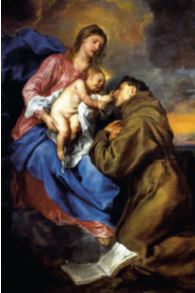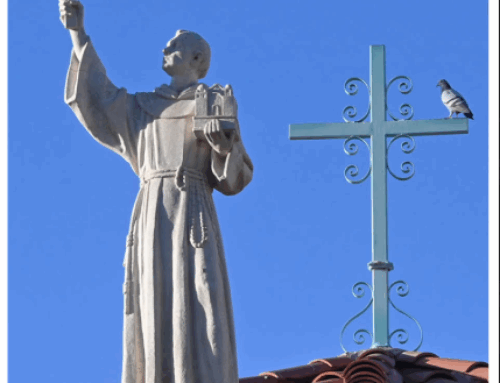(This article originally appeared in the TAU-USA Fall 2020 Issue #101)
 by Christopher Shorrock, OFM Conv., CNSA
by Christopher Shorrock, OFM Conv., CNSA
This year marks the Eighth Centenary of the “Franciscan vocation of St. Anthony of Padua” as Pope Francis remarked in his letter to Carlos Trovarelli, Minister General of the Friars Minor Conventual commemorating this event, dated February 15, 2020.
On January 16, 1220, the young Augustinian Canon Regular, Fernando Martins de Bulhões, on hearing of the martyrdom of five Franciscans in Morocco, decided to enter the Franciscan Order and became known to the world as Anthony of Padua.
Anthony died on June 13, 1231, at the Poor Clare monastery at Arcella (now part of Padua), aged 35, and was canonized by Pope Gregory IX on May 30, 1232, at Spoleto, Italy, less than one year after his death.
Pope Pius XII proclaimed Anthony a Doctor of the Church on January 16, 1946, and gave him the title Doctor Evangelicus [“Evangelical Doctor”] since the freshness and beauty of the Gospel emerge from his writings.
St. Anthony is a popular saint, a wonderful preacher, and a great miracle worker; only a few have looked upon him as a deep theologian or a learned teacher.
Perhaps one lesser known fact about St. Anthony is his great devotion to the Blessed Virgin Mary and, on account of the many references to Mary in his sermons and expressive passion with which he speaks of her, he might well be called, like St. Bernard of Clairvaux, whom he so frequently quotes, a second “Marian Doctor.”
With regards to the sources for his doctrine on Mary, we possess eight sermons1 of St. Anthony on the Blessed Virgin Mary: one on the Birth of Mary, three on the Annunciation, three on the Purification, and one on the Assumption.
These are numbered among his Sermones Mariales. Besides these, however, we find references to the Blessed Virgin Mary in many of his Sunday and Feast Day sermons, especially in his sermon for the Third Sunday of Lent, which says: “Blessed is the womb that bore thee, and the breasts that nursed thee” (Luke 11:27).
These are known as his Sermones Dominicales [Sunday sermons]. Among his Sermones Solemnitatum or Sanctorales [Sermons for Solemnities or Feasts] there are four other sermons or outlines for the Purification, and six additional outlines for the feast of the Annunciation.
Furthermore, all the sermons on the mysteries of our Lord’s life highlight Mary; for example, his sermons for the Feasts of the Nativity of our Lord, of the Epiphany, and of the Resurrection.
One writer stresses the fact that the St. Anthony’s whole life seems to revolve around the Blessed Virgin Mary, which he styles a Vita Mariana [Marian life].
He is said to have been born on the feast of the Assumption, August 15, 1195, in Portugal, a country known since the end of the 12th Century as the “Land of Mary,” to whom it was dedicated by Alphonse I after the victory over the Moors.
The cathedral of his native city, Lisbon, was sacred to the memory of the Assumption; his mother, Donna Maria, offered her infant son to Mary before a statue of Mary’s Immaculate Heart while chanting the Magnificat; Anthony was baptized on August 22, the octave of the Feast of the Assumption, which today is dedicated to the Queenship of Mary.
An ancient tradition tells us that Anthony’s first words were an invocation to Mary–Maria; his last words were a final salutation to his Lady Queen in his O gloriosa Domina [O glorious Lady] to whom as a child he dedicated his virginity.
St. Anthony’s later sermons on the Blessed Virgin Mary are substantially and theologically so exhaustive and so complete, that one Belgian Franciscan felt he could stake his reputation as a scholar by asserting that “St. Anthony’s sermons give us a complete Mariological theology”; whereas an Italian biographer of St. Anthony writes:
There is not a trait in the life of Mary to which he [St. Anthony] did not dedicate a page or two; not a mystery in her life that he did not study profoundly and correspondingly expound to his listeners. He allowed no occasion to escape on which he might dedicate his ardent zeal to inculcate devotion to her or propagate her cult. And if there is no Catholic doctrine he did not illustrate, it must be admitted that he preferred to treat those which referred to Mary.
Although the sources of St. Anthony’s Mariology were both the Sacred Scriptures and Tradition, he quotes the former so frequently that one might call his Mariology Biblical. Pope Gregory IX aptly called him an “Ark of the Covenant,” for within were kept the Sacred Books. One author, writing of the Mariology of the Evangelical Doctor states that this:
Reveals his ability as an interpreter of Sacred Scripture. In it we may observe excellent use of the literal sense of the Bible, and some of the richest types that are to be found in his sermons. When he speaks of Mary, St. Anthony does not spare himself in his efforts to sing her praises. To him the Blessed Virgin is the Queen of all creatures, and her prerogatives were constantly in his mind when he spoke to others. The Scriptures furnish him with the phrases that he sought to describe Mary’s pre-eminence just as they had been his inspiration in other matters.
In arguments taken from tradition, St. Anthony borrows especially from the great Marian doctors: St. Augustine, St. John Damascene, St. Bede the Venerable, and St. Anselm, but above all, from St. Bernard of Clairvaux.
His Mariology not only embraces all the accepted beliefs of medieval scholastics, but reaching far beyond his own times, sufficiently indicates other doctrines that only centuries later were either defined as dogmas (the Immaculate Conception of Mary, the Assumption of the Blessed Virgin Mary) and are definitely accepted today as Catholic doctrine and common theological teaching; or form a part of the present liturgical system of the Church as embodied in the devotion to Mary under various new titles which, like so many recently detected stars in the firmament, have been added in the form of new jewels to Mary’s crown, such as the doctrine of Mary’s being the Co-Redemptrix of the world, the Mediatrix of all graces, etc.
The fundamental principle of St. Anthony’s Mariology, around which everything else revolves, is Mary’s Divine Maternity and the Virginal Birth of the Saviour. This once established as the final cause, St. Anthony proceeds to develop all the other privileges of Mary either introductory to it or subsequent upon it.
Let us conclude with the word of our holy father, Pope Francis, “may his [St Anthony] example of sharing in the difficulties of families, the poor and disadvantaged, as well as his passion for truth and justice, still arouse in us today a generous commitment to give of ourselves as a sign of fraternity.”
This article is part of the introductory remarks for a much larger work on the Mariology of St. Anthony that Fr. Chris is working on. Fr. Chris holds a Doctorate in Theology and is currently an adjunct lecturer at Sacred Heart Seminary and School of Theology, Hales Corners, WI.
_____________________________
See the 4-volume series on Saint Anthony of Padua, Sermons for Sundays, and Festivals, translated by Paul Spilsbury (Padova: Messaggero Di Sant’Antonio, 2007).


Excellent Info on Devotion and Secrets of Mary.